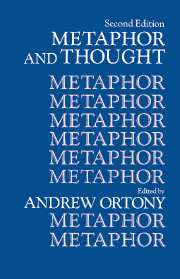Book contents
- Frontmatter
- Contents
- List of contributors
- Preface to the second edition
- Preface to the first edition
- 1 Metaphor, language, and thought
- METAPHOR AND MEANING
- METAPHOR AND REPRESENTATION
- METAPHOR AND UNDERSTANDING
- 14 Psychological processes in metaphor comprehension and memory
- 15 The interpretation of novel metaphors
- 16 The role of similarity in similes and metaphors
- 17 Images and models, similes and metaphors
- 18 How metaphors work
- 19 Metaphor and irony: Two levels of understanding
- METAPHOR AND SCIENCE
- METAPHOR AND EDUCATION
- References
- Author index
- Subject index
16 - The role of similarity in similes and metaphors
Published online by Cambridge University Press: 05 June 2012
- Frontmatter
- Contents
- List of contributors
- Preface to the second edition
- Preface to the first edition
- 1 Metaphor, language, and thought
- METAPHOR AND MEANING
- METAPHOR AND REPRESENTATION
- METAPHOR AND UNDERSTANDING
- 14 Psychological processes in metaphor comprehension and memory
- 15 The interpretation of novel metaphors
- 16 The role of similarity in similes and metaphors
- 17 Images and models, similes and metaphors
- 18 How metaphors work
- 19 Metaphor and irony: Two levels of understanding
- METAPHOR AND SCIENCE
- METAPHOR AND EDUCATION
- References
- Author index
- Subject index
Summary
The chapter by Alan Paivio and Mary Walsh is like a tool kit; it provides the potential for undertaking a serious examination of our problem. The question that now has to be asked is whether it contains the right tools. I suspect that as with most tool kits, some of the tools are useful for the problem at hand and some are not. In this chapter, I shall concentrate on the tool that I believe to be the most important, namely, similarity. I shall also discuss briefly two other issues raised by Paivio and Walsh, namely, integration and relation.
Paivio and Walsh argue that the central question surrounding the comprehension (and the production) of metaphors concerns the way in which a novel conception arises from apparently disparate parts. This question, they claim, involves three important concepts, namely those of integration, relation, and similarity. Similarity is involved because the two terms in a metaphor share attributes. Relation is implicated, because a metaphor may take advantage of common relations, and also because of its involvement in integration. Integration is significant because of the emergence of something new, presumably a result of integrating certain aspects of the parts. As I have said, I think that the most important of these three concepts is that of similarity. For that reason, I shall devote most of my attention to the role of similarity in metaphors, and especially in similes.
- Type
- Chapter
- Information
- Metaphor and Thought , pp. 342 - 356Publisher: Cambridge University PressPrint publication year: 1993
- 33
- Cited by



